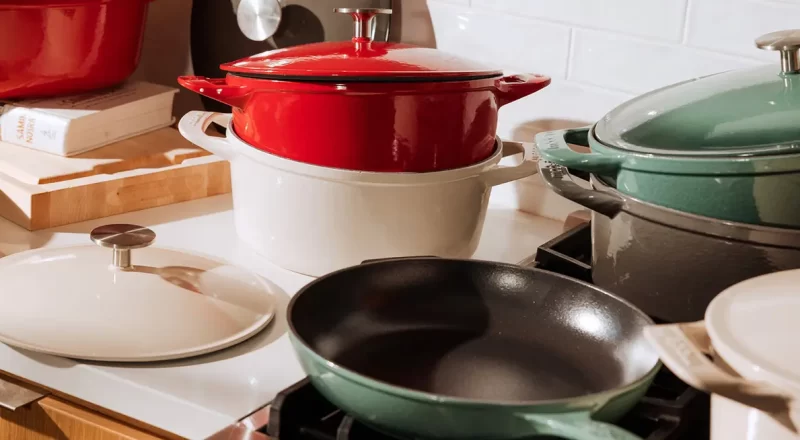Dutch ovens have become an indispensable part of many kitchens, cherished by both home cooks and professional chefs. But where did Dutch ovens come from? This article delves into the fascinating history, development, and enduring relevance of these versatile kitchen staples.

The Origins of the Dutch Oven
Dutch Influence
The term Dutch oven is believed to have originated in the early 18th century. Dutch traders were famed for their efficient sand-casting techniques, which allowed them to produce high-quality cast iron cookware. This technology was both innovative and highly sought after.
Abraham Darbys Innovation
Abraham Darby, an Englishman, played a significant role in popularizing the Dutch oven outside the Netherlands. In the early 1700s, he traveled to the Netherlands to learn their casting techniques. Upon returning to England, he started producing cast iron cookware that resembled the Dutch design, which he further refined and improved.
:max_bytes(150000):strip_icc()/Web_1500-Testing-LeCreuset7.25QuartRoundDutchOven-16-WillDickey-1238-272-39e8c8ce0ce742f89c02f23acbee4664.jpg)
Evolution Through Time
Colonial America
In Colonial America, the Dutch oven became a fundamental cooking tool. American colonists valued its durability and versatility, using it for baking, frying, and stewing. It became an essential part of the American culinary tradition.
Modern Developments
Todays Dutch ovens have evolved significantly from their early ancestors. Modern designs often feature enameled surfaces, which make them easier to clean and maintain. Cleaning a Dutch oven has never been simpler, thanks to contemporary advancements.

The Construction of a Dutch Oven
Material Choices
Traditional Dutch ovens were made of cast iron, a material known for its excellent heat retention and even cooking. Today, you can find them made from various materials, including aluminum and ceramic, each offering unique benefits.
Design Features
One characteristic feature of a Dutch oven is its heavy, tight-fitting lid. This design helps to seal in moisture and flavor, making it ideal for slow-cooking and braising. The handles are also designed for easy lifting, adding to its practicality.
Uses in the Kitchen
Versatility in Cooking
The Dutch oven is incredibly versatile, capable of performing a variety of cooking methods. From roasting and baking to frying and braising, its utility in the kitchen is unparalleled.
Popular Recipes
Some popular dishes that can be made in a Dutch oven include casseroles, soups, and even bread. If you’re looking for ideas, you can check out how to make chili in a Dutch oven and start experimenting in your kitchen.
Care and Maintenance
Seasoning the Dutch Oven
Proper care is essential to maintain the longevity of your Dutch oven. Seasoning the cast iron helps protect it from rust and enhances its non-stick properties. Learn more about this process from seasoning your Staub Dutch oven.
Dealing with Common Issues
Its not uncommon for your Dutch oven to develop issues like sticking. This can usually be remedied by ensuring proper seasoning and cleaning techniques. Learn why your Dutch oven sticks and how to solve it.
The Cultural Impact of the Dutch Oven
Around the World
The Dutch oven is not just popular in Western cooking. It has found its place in kitchens around the globe, adapting to various culinary traditions and cooking styles.
In Popular Media
Over the years, the Dutch oven has been featured in numerous cooking shows, magazines, and even movies. Its iconic status in the culinary world makes it a favorite among chefs and home cooks alike.
Modern-Day Popularity
In Professional Kitchens
Professional chefs often prefer using Dutch ovens due to their durability and versatility. They are a staple in many high-end restaurants kitchens.
Among Home Cooks
Home cooks also adore the Dutch oven for its ability to handle a variety of cooking tasks. Its popularity among amateur cooks continues to rise, aided by the plethora of recipes and tutorials available online.
Buying Guide for Dutch Ovens
Choosing the Right Size
Selecting the right size is crucial. If youre unsure, find out the most common size Dutch oven before making a purchase.
Material Considerations
Consider the material of the Dutch oven. While cast iron remains a popular choice, other options like ceramic and aluminum may better suit your needs.
Environmental Impact
Sustainability
With a growing focus on sustainability, the Dutch oven stands out for its durability and longevity, reducing the need for frequent replacements.
Eco-Friendly Manufacturing
Many manufacturers now employ eco-friendly processes in the production of Dutch ovens, making them a responsible choice for environmentally conscious consumers.
Conclusion
So, where did Dutch ovens come from? From their origins in Dutch casting techniques to becoming a beloved kitchen staple worldwide, the Dutch oven has a rich history. It continues to prove its worth in modern kitchens, thanks to its versatility, durability, and timeless appeal.
If you found this article helpful, consider reading more on how a Dutch oven is different from a pot.
FAQs
What makes a Dutch oven special?
The Dutch oven is renowned for its versatility, durability, and ability to retain heat evenly. These qualities make it ideal for a wide range of cooking methods, from baking to braising.
How do I care for my Dutch oven?
Caring for a Dutch oven involves proper cleaning and seasoning. Make sure to avoid harsh detergents and always dry it thoroughly to prevent rust.
Can I use a Dutch oven on all types of stovetops?
Yes, most Dutch ovens are designed to be used on various stovetops, including gas, electric, and induction. Always check the manufacturers guidelines to be sure.
As an Amazon Associate, I earn from qualifying purchases.

